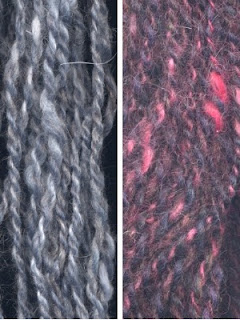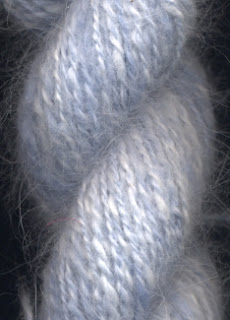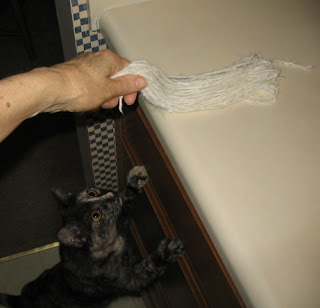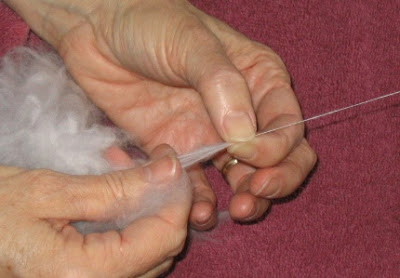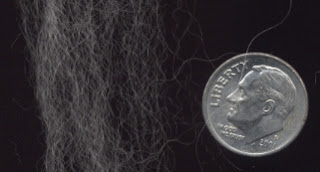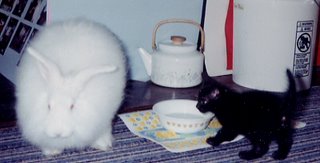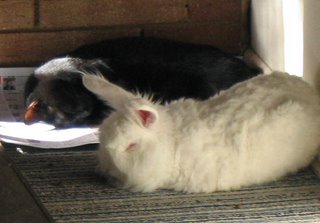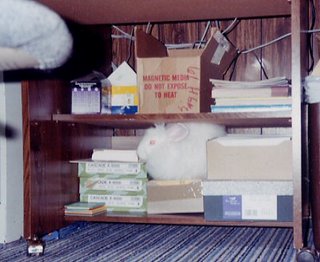Ever since I switched from front to back, to back to front warping, I've been enjoying weaving a lot more. Even though I learned to weave 7 years ago, it has only been for the past year that I've had the time to really apply myself to it. I feel as though I spent 6 years dabbling and at last have the opportunity to become serious about it.
Each time I put on a new warp I look for ways to improve it. I realize that there are a lot of different ways to accomplish the same things, it's a matter of finding what works best for oneself and one's loom.
The question on my mind lately has been whether or not to leave the raddle in while weaving. I had been taking it out, but found some decided advantages to leaving it in; the first being a way to keep the lease sticks from creeping toward the heddles.
 The first time I tried this, I tied the lease sticks together but found there wasn't enough give in the warp and several ends broke. The idea to use the rings isn't actually my own, I borrowed it from Charleen, which she uses during warping, and I thought to use during weaving. This worked better and allowed some give in my warp. No more bound and broken ends!
The first time I tried this, I tied the lease sticks together but found there wasn't enough give in the warp and several ends broke. The idea to use the rings isn't actually my own, I borrowed it from Charleen, which she uses during warping, and I thought to use during weaving. This worked better and allowed some give in my warp. No more bound and broken ends!Everything was going well, or so I thought, until I read an Online discussion concerning where the warp passes through the heddle eye. It should be through the center, right? So I took a look and was alarmed when I discovered that it wasn't......
 You can see the dip my warp makes as it travels over the raddle on it's way through the heddles, where it rubs under the top of the heddle eye. You can also see where my floating selvedge lies, which indicates the degree of the dip the warp takes. The raddle adds an additional ¾ inch to the height of the warp. More actually, as the raddle doesn't sit exactly on top of the back beam. So in between dishtowels I took the raddle out. And you know what? My warp still hugs the top of the heddle eyes. Oh well.
You can see the dip my warp makes as it travels over the raddle on it's way through the heddles, where it rubs under the top of the heddle eye. You can also see where my floating selvedge lies, which indicates the degree of the dip the warp takes. The raddle adds an additional ¾ inch to the height of the warp. More actually, as the raddle doesn't sit exactly on top of the back beam. So in between dishtowels I took the raddle out. And you know what? My warp still hugs the top of the heddle eyes. Oh well. Speaking of floating selvedges, after a lot of experimenting, I have finally decided that I like to hang them off the back of the loom in a weighted film canister.
Speaking of floating selvedges, after a lot of experimenting, I have finally decided that I like to hang them off the back of the loom in a weighted film canister.I've tried winding them on with the rest of my warp, but hanging them separately seems to work better for me. Especially as I often need a little give to them when I throw the shuttle and miss one of them somehow.
I use fishing weights inside the canister, and have discovered that these, with the help of a bent paper clip, are also good for the occasional loose warp thread .....
 My other tweak involves measuring my progress. This worked better than simply measuring every time I advanced the warp and marking my place with a bit of thread, but this .....
My other tweak involves measuring my progress. This worked better than simply measuring every time I advanced the warp and marking my place with a bit of thread, but this ..... ..... works even better. It was Peg's suggestion; bias tape with marks I made on it (which you can't see). I pin it as I advance the warp, and unpin it before it winds onto the cloth beam. I had heard of using a cloth quilters tape measure, but never could find one. It hadn't occurred to me to make my own, so I appreciate this idea.
..... works even better. It was Peg's suggestion; bias tape with marks I made on it (which you can't see). I pin it as I advance the warp, and unpin it before it winds onto the cloth beam. I had heard of using a cloth quilters tape measure, but never could find one. It hadn't occurred to me to make my own, so I appreciate this idea.All in all, I feel like I'm making good progress; my weaving looks better and I'm enjoying it more. Maybe I'll make it past the novice stage one of these days after all.
© 29 March 2007 at http://leighsfiberjournal.blogspot.com
Related Posts:
f2b Versus b2f - Beginning of a series
Evaluating My b2f Warp
B2F Vs. F2B - Why I Switched












